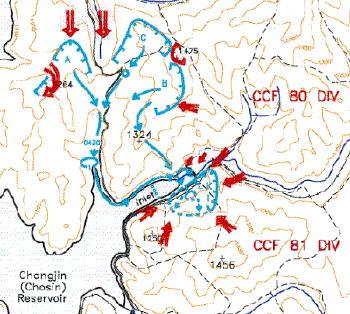
Map 8‐6 The Chosin Chronology
Click on the map for a full‐screen image; use your
Back button to return to this text.
Withdrawal of
1/32 to the Inlet. Note the dotted line crossing the Inlet; this is the area where Col.
MacLean crossed the ice and was wounded and captured by the Chinese.
Columns of troops formed on
each side of the vehicles and moved to the front. All preparations had been completed by
about 0430 hours and the column began to crawl forward. Many vehicles that could not be
started had to be left behind, but none of the wounded were without transport. That was
the important task at the moment. It was strangely quiet behind as we moved down the
road towards the 3d Battalion. Our rear guard reported later the Chinese seemed content
to allow us to withdraw without any extreme effort on their part to follow closely.
Actually this must have been true. I believe the enemy spent time looting the area we
had evacuated before organizing for an effective pursuit. Their need for supplies was as
acute as ours. About daylight we had progressed to the vicinity of the former regimental
CP site before the column was halted.
I walked forward along the
vehicles and soon came abreast of Col. MacLean's jeep with only his driver. A few
yards beyond was a bend in the road which shut out the view. I was informed the colonel
was on the road making a reconnaissance of a reported roadblock that had caused the
halt. A small straggling group came from the direction of the bend and told us a company
of our troops was encircling the roadblock. No one seemed to know exactly where the
colonel was, but I suspected at the time he was with the company going after the
roadblock. That suspicion was proved wrong as I shall relate later; he was ahead of the
company! As we waited for the go‐ahead signal someone came down the line of
vehicles yelling that vehicles were to get off the road and disperse in an open area on
our left. We promptly drove into the area and dismounted. When some 60 vehicles were so
placed, personnel were instructed to take up a defensive position in case the Chinese
caught up with us again or tried to come in on our left flank before we could resume our
road march. We waited for what seemed hours and were getting more concerned by the
minute, as we knew the Chinese behind us would not fool around all day going through the
abandoned area we had occupied, and would soon be hot‐footing down the road
toward us.
CAUGHT BY SURPRISE
Soon a small squad of Chinese
did just that and were as surprised as we were. They had come trotting around a bend in
the road not 20 feet from the nearest vehicle. In a moment of firing was going on all
directions. The enemy must have thought they had run into an ambush and took to their
heels. Lt. McNally and I had taken cover beside a mud house and for a few minutes I
thought that a sizable force had begun an attack on our position. Then someone began and
others repeated the call to cease fire, and all became quiet. Order was
restored.
I made my way up the road again toward the location of the
roadblock and once more came upon the colonel's jeep. This time his bodyguard and
radio operator, who rarely ever left the colonel's side, were looking concerned and
talking excitedly. I was told the colonel had not gone with the enveloping company
toward the flank of the roadblock, but had gone boldly down the road directly toward the
obstacle and had not returned. It might be explained at this time that about a mile
separated our halted motor column and foot elements of the 1st Battalion from the site
of the roadblock; and just in front of the roadblock was a
hundred‐foot‐long concrete bridge over the frozen inlet of the reservoir.
A scant 200 yards beyond the bridge was the encircled 3d Battalion, our goal. I moved
cautiously to the bend where I had view of the bridge. With field glasses I could make
out troops along the bridge supports firing at some target on the opposite side of the
bridge.
About this time Lt. Col. Faith came striding up with the news
that his company had cleared the roadblock. The men I observed were our own troops
holding the bridge and would cover our dash over and to the safety of the 3d Battalion
area. That was the plan. Start up the vehicles again, get them on the road and send them
one at a time over the bridge which was still under fire from the surrounding hills,
though it was held by our troops. With the Chinese at our backs there was no hesitation
in anyone's mind. Drivers floor‐boarded their accelerators as we ran the
gauntlet. Although some of the vehicles got hit, no casualties were reported. We
regrouped on the far side of the bridge. I felt quite lucky as we pulled to the halt,
and after inspecting our jeep found not a single hole.
Leaving the
jeep parked in the new area I set out for the 3d Battalion CP where I found Lt. Col.
Reilly propped on a stretcher with a bullet hole through his leg and grenade splinters
lightly sprinkled in his arms and shoulder. He was in good spirits and chatted with me
about the situation in general. Lt. Col. Faith came in at this time and went into
immediate conference with Reilly as they laid plans to consolidate the two infantry
battalions and the field artillery battalion.
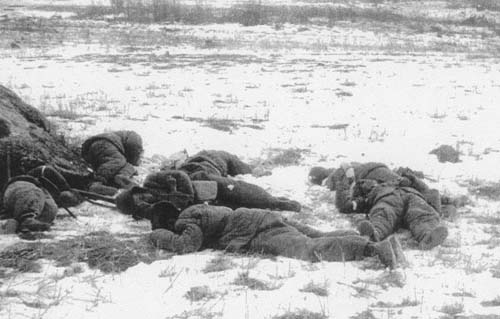
Dead Chinese soldiers. "Dead Chinese
soldiers shot by Retherford and Donovan inside the perimeter near the 3/31 command
post." ‐ MSG Wm. Donovan
I cornered Capt.
[Robert] McClay, 3d Battalion adjutant, and got from him the story of the hammering and
slashing they had taken from the enemy the night before. One had only to look about as
he told the story to confirm everything he said. Dead and wounded GIs lay in and around
the Korean mud house that served as a CP, and just a few yards beyond I counted 20 dead
Chinese in their now familiar quilted jackets and tennis shoes. In fact, they were
strewn throughout the area giving evidence of their penetration into the foxholes of the
beleaguered battalion and its command post. How the Chinese were finally pushed back as
dawn came, and how those soldiers of the 3d Battalion kept firing until the Chinese
retired to the protection of the hills, will be a tribute to that unit forever. Capt.
McClay said simply there was nothing else to do and no place to go, so they just stayed
in their holes and shot Chinese until the fanatical enemy had enough and
withdrew.
TWO OFFICERS WERE DYING
Casualties in the
battalion ran high, especially among the officers. Dropping by another mud hut that
served as a hospital, I found Capt. [Melville E.] Adams, S‐4 of the 3d Battalion,
dying of wounds as was Lt. [Paul N.] Dill [M3/31], a fine officer. Capt. Wamble of the
31st Medical Company was also in a bad way with bullet wounds through his lungs; he
could hardly speak above a whisper as I chatted with him briefly. We had been good
friends back in Japan and I was shocked to see Henry in such a state. He was pessimistic
about our chances of getting out and showed me his .45 pistol which he dragged out from
under the blanket. He told me that he would shoot himself rather than let the Chinese
capture him. That was the last time I saw Henry, and though he was placed on a truck
when we finally left the area, he was never reported to have made it to
Hagaru‐ri. How he fared we will probably never know.
When I
returned to the area where Lt. Col. Faith had established his CP, I learned that Col.
MacLean had been captured a short while before. It was reported he had mistaken a group
of Chinese for GIs, and upon running towards the group he was fired on and wounded. He
struggled to his feet, the report went on, and again started toward the group and was
shot down once more. This time men in the group who were identified as Chinese dragged
the colonel off with them as they withdrew. This action had taken place in the vicinity
of the roadblock. The colonel was never seen again and is listed as
missing.
As the afternoon [29 November] wore on we set about digging
foxholes and establishing the 1st Battalion into the defenses of the other units already
there [3/31 and 57FA]. I took over Col. MacLean's jeep and crew. Together we dug
into the side of a small embankment, with an overhead cover of logs. This would give us
partial protection from any direct hits by mortar shells or artillery bursts overhead.
Leaving the men to lay out sleeping bags inside our new home, I went to search for Lt.
Col. Faith and his executive officer. He had taken over after viewing the condition of
the other two battalion commanders. I was appointed the "task force
S‐4." I set about organizing the collection of supplies in the area so that
equal distribution could be made. About 1530 hours my supplies were built up by an
airdrop. Two C‐119 Flying Boxcars were overhead and after two trial passes
spouted their cargo of colored parachutes with much‐needed ammunition and
rations. One of the chutes failed to open and the heavy cargo came down like a stone.
Before we could get off a warning it hit among a group of ROK soldiers about 20 feet
from me, killing one of them immediately. After that, when an airdrop was pending, loud
yells of warning kept everyone alert for falling cargo.
'COPTERS TAKE OUT
WOUNDED
About an hour after the airdrop two helicopters in the vicinity
were contacted and directed to land within our perimeter. They evacuated a few of
the more seriously wounded to Hagaru‐ri that afternoon, but darkness
prevented them from making but two trips out and back. The next day when our forward
air controller (FAC) contacted them, we learned that other units in similar trouble
had priority over us.
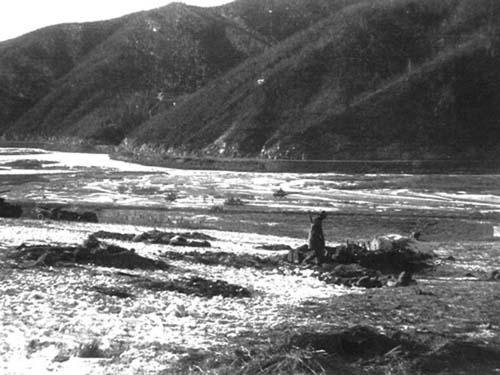
"Inside the Inlet perimeter. In center
of the picture are three helicopters that landed to pick up wounded, landing about
400 yards west of the bridge/causeway. To the left is a 40mm M‐19 track of
D/15th AAA. In the center foreground is mortar position of L3/31. Man in the photo
by the hole is squad leader SGT Luther Crump." ‐ MSG Wm.
Donovan
With a
strengthened defense we stood our watches that night and set ourselves for attacks
we knew would come about midnight. About 2300 hours our artillery began to fire and
the cough of our mortars started up. Next the machine guns on the perimeter took up
the chatter and were joined by the firing of our M‐1 rifles. The crack of
rifle and machine gun bullets coming in overhead told us the Chinese were coming
from the hills to the south and into the defense of the newly arrived 1st Battalion.
The Chinese wanted to try them out. The reception was too hot and in about an hour
the Chinese gave up trying. With a lot of bugle blowing they returned to the hills.
All became quiet again. And so it went for the rest of the night and early morning
with only occasional firing of our mortars on suspected enemy positions and
infrequent fire from our outposts. This was surprising as we had expected the enemy
to double his efforts that night.
Daylight came slowly on 30
November with ground fog persisting until after 0800 hours. About 1000 hours the
skies cleared and another air‐ drop came in, bringing more precious supplies.
We were still short of ammunition and appealed over the radio to the aircraft for
more. Gen. [David] Barr, our division commander, paid us a surprise visit that
morning and promised to do all he could to get us better supplied by air. He was
quite worried, as I had never seen him before, and for good cause. His information
was that a tank‐led task force had been trying for two days to reach our
surrounded garrison and had been severely mauled and turned back. We then realized
the full gravity of our situation. Lt. Col. Faith decided that he would prepare to
fight our way out of the trap, but wanted to get better supplied with ammunition
before making the effort.
That night we went into our holes and
waited for the Chinese. They didn't disappoint us. About 2000 hours they began
to lob 120mm mortars and light artillery into our perimeter. We could hear the dull
boom of guns followed by the swishing of projectiles singing through the air all
about our emplacements. Our 105mm artillery began retaliation but their fire went
unobserved and probably did the enemy batteries little damage. The Chinese fire was
in preparation for an assault by foot troops and kept up for about 45 minutes.
Luckily none landed close to our hole to cause more than an occasional shower of
dirt. We could hear the smack of steel when fragments hit an exposed vehicle, and
that was often. Some of the men weren't as lucky, as I could hear calls for a
medic from several directions.
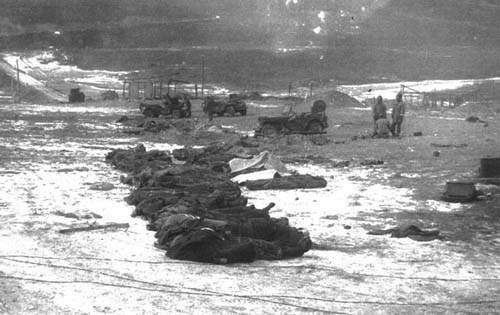
"Bodies of soldiers from 3/31 killed
inside the perimeter. Most are from Company L and Battalion Headquarters Company.
Burial was not possible because of frozen ground." ‐ MSG Wm.
Donovan
MORTAR FIRE
WOUNDS MEDICS
The aid station the 3d Battalion had set up that afternoon
was directly behind our hole and had the misfortune of receiving two near hits by
incoming mortars which wounded some of the medics and those already wounded. The
heavy stuff lifted and the enemy gunners began to step up their pace. The Chinese
who had been creeping nearer and nearer all this time began to pour in with their
burp guns and rifle fire. The snow outside our hole spurted every now and then as a
slug plowed into the dirt. The air over my
head was alive with the buzz and
crack of incoming bullets. We could hear the yells of our own troops mingled with
those of the Chinese as the outer defenses clashed.
Our troops
withheld fire until the enemy was well within range, then cut loose with everything
they had. Attacks were being made on all sides. There was business for
everybody.
All night waves of Chinese soldiers attacked our lines
and were held off. Our machine guns were taking a terrible toll and our artillery,
having lowered their guns to fire point‐blank at the screaming hordes, hacked
huge holes in their ranks. Very few Chinese infiltrated past the outer perimeter and
those who did were killed before they could do much damage.
There
was one sniper who proved troublesome all during the early morning hours by firing
past our foxhole into the dirt beyond. Evidently he was causing others trouble also,
as a patrol was formed and came by our hole with the mission of locating and
eliminating the sniper. He could not have been more than 20 yards behind us but was
so well hidden in the murky darkness that they could not find him. He kept up his
firing off and on until well after daylight, then his fire suddenly ceased. Someone
got him or he took off. Anyway, it became safer to come out of our holes. Although
the Chinese withdrew from the edge of the perimeter, they still kept up a harassing
fire and casualties among our men continued. The morning of 1 December at about 0900
hours I crawled out to our jeep and dug up a can of frozen beans. Others found the
same fare and we went back to our hole and built a small fire but it wasn't
enough. We ate the rations anyway. Nothing so delicious as ice crystals in your
beans! That was all we had so there wasn't much bitching about the chow. No one
volunteered to scout for more wood to build another fire so the topic of food came
to a rapid close.
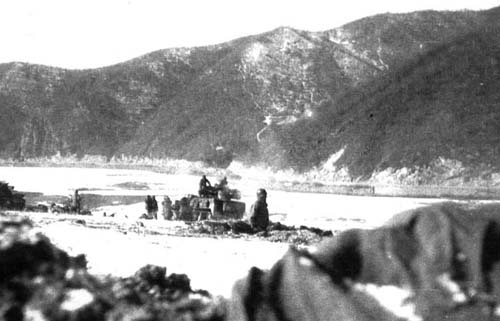
"Inside the perimeter. A small Chinese
attack was moving in from the hill to the right and rear of the bridge. The
M‐16 Quad‐50 machine guns are firing into the attacking Chinese."
MSG Wm. Donovan
CLOUDS LIFT,
CORSAIRS ATTACK
The low‐hanging clouds still persisted and we began
to sweat for fear that our daily fighter cover and expected airdrop would not come.
Our position on the ground was obscured by the clouds. About 1100 hours, however,
the sun broke through and our fighters came in to begin one of the prettiest shows I
have ever seen. They dived and dived again, covering the surrounding hills with
deadly rocket and machine gun fire. They dropped oblong containers of napalm that
sent up terrible pillars of flame. The Chinese dreaded napalm and cleared out when
it hit nearby. Lt. Col Faith came over to our hole and in a few quick sentences told
me the time had come to get out of there. He told me we must get the trucks warmed
up and the wounded loaded. At last we were going to try to break out of the ring of
Chinese. Waiting for airdrops was futile. We set about rounding up drivers and
getting the troops organized for the fight. It was within 10 minutes of my talk with
Lt. Col. Faith when I was taken out of the play.
I was making my
way to the 57th FA Battalion CP when an explosion knocked me sideways and down to
the ground. Stunned for a moment, I did not realize that a mortar round had landed
no more than three feet from me and shrapnel had hit me in the arm and leg.
Lt. McNally also became a casualty from the same burst. I looked at
my
carbine which had been blown from my hand and discovered it was useless.
The force of the explosion or some fragments had exploded several rounds in the clip
and the slide mechanism would not work. Sgt. [John] Lynch, my sergeant major,
reached me in a couple of minutes and helped me to a slit trench nearby. He rolled
up my pants, bandaged the gash in my leg and bound my arm. It wasn't bad as I
could hobble around. Lynch led me to a truck and put me aboard, telling me to stay
put. Other wounded were placed on the truck as preparations to leave were stepped
up. I lay face down in the left front of the truck bed and watched what was going on
through the slatted sides of the vehicle. Artillery gunners were dropping
phosphorous grenades down the muzzles of their guns. Jeep drivers were jabbing
bayonets into the tires of their abandoned vehicles and setting fire to them.
Remaining records and documents that could not be risked to capture were set afire
and supplies were soaked in gasoline and burned. The Chinese were well alerted to
our plans and had begun to throw in more mortar fire and became bolder with their
rifle fire. At last our trucks were loaded and our troops deployed beside the truck
column. At a signal we moved out. Marine and Navy aircraft dove into the wall of
enemy ahead and blasted with all they had. Ahead of our truck was a tracked vehicle
mounting a 40mm gun, but short on ammunition. Also ahead of our truck was a jeep
with a .30 caliber machine gun mounted on the front. This was our spearhead. Our
troops on either side of the road moved forward but were dropping from the withering
fire laid down by the Chinese as we moved forward.
NAPALM
SPLASHES OUR RANKS
Then came one of the most horrible sights I ever hope to
witness. A Marine Corsair diving toward the enemy line just ahead of our troops
dropped a tank of napalm that slammed into our front line of advancing GIs. A wall
of flame and heat rushed out in all directions, enveloping about 15 of our soldiers
in its deadly blanket. The heat and flash caused me to duck momentarily. Looking
back up I could see the terrible sight of men ablaze from head to foot, staggering
back or rolling on the ground screaming for someone to help them. This, coupled with
the steady whack of enemy bullets into our ranks, stopped the advance. I am quite
sure I recognized the helpless and blazing figure of Sgt. Dave Smith, my assistant
sergeant major and one of the finest men I have every known. He wasn't more
than 10 yards off the side of the road and I was powerless to do anything for him. I
had to turn my head. Officers and NCOs, through superhuman effort, rallied their men
and soon our line of GIs began to move forward again, filling the blackened gap that
had been blasted open minutes earlier. Our truck began to move forward once more and
I breathed a prayer of thanks, the first of many prayers that day. At least we were
through the first ring of Chinese who had surrounded our group two days before. They
were still in the hills on our left and hidden in the brush along the road, laying
down a hail of lead into our troops and trucks.
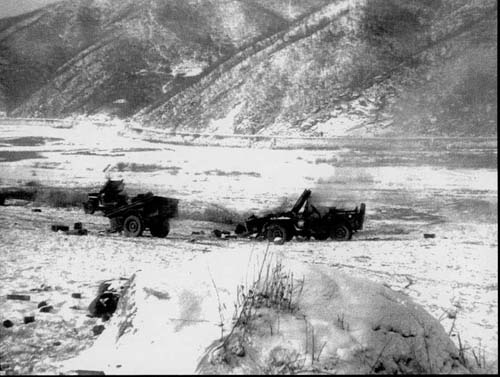
"Last photo inside the perimeter.
Donovan had gone back to make sure all equipment in his mortar position had been
destroyed, setting this jeep on fire." ‐ MSG Wm. Donovan
My leg began
to throb and I had to keep shifting to keep a more severely wounded man from rolling
on me. He was unaware of the whole ruckus and kept trying to raise up, especially
when a bullet smacked into the truck. I quieted him the best I could by telling him
we were going to get out, although I had my doubts. The other wounded on the truck
just lay quietly and stared into nothing. Most of them had been wounded before that
day and were on litters. None of them able to walk at all. As we moved forward in
jerks and halts, a few frightened ROK soldiers tried to climb into the truck but
were pulled off by GIs beside our vehicle. From my peephole I could see dead Chinese
and American soldiers lying in little sprawling heaps on the side of the road, their
blood forming pools from which steam rose into the freezing air. I remember looking
at this and realizing the fight those Gis were making. Soldiers passing our truck
called out encouragement and grinned as they went forward to fight more Chinese or
fall themselves. The enemy was giving way now and our men sensed it, following them
more closely and with greater courage.
About three miles down the
road we came to a bridge which had been destroyed. Our motor column turned off the
road into a wide riverbed to bypass the obstacle. Great mounds of frozen earth
covered with a tough grass carpeted the riverbed. For about 100 yards we bounced and
crashed up and down over those hummocks with the wounded screaming in anguish as
they were jostled and slammed into one another. Luckily I still had on my steel
helmet and thus was able to protect my head, although I had a bruised head for days
afterward. We came to a final jolting crash and stopped. Our front wheels were down
through a crust of ice in a small creek and no amount of effort on the part of our
driver could move the truck forward or backward. To top it off the engine went dead
and the driver departed as enemy fire began to crackle around our stalled truck.
Other vehicles began to come abreast of us and with more caution were able to ford
the creek. Again I began to sweat. Was this going to be the end of the
road?
After what seemed to be hours (actually a short time) a
tracked vehicle backed up to our truck, hooked on a tow rope and pulled us through
the creek to firm ground. Our driver returned and once more we moved slowly forward.
We reached the road and after a halt to allow other vehicles to cross the difficult
bypass, we got under way. The hills were now on the right side of the road and on
our left the ground fell sharply away to form a valley paralleling our course to the
south. Heavy small arms fire was coming down at the column from the high ground on
our right and the continual smack of slugs against the truck was unnerving to me, as
I expected any minute to be hit by the next one. A heavy‐set Korean soldier
was lying next to me and once when I turned to look his way I saw his jacket sleeve
jerk as a slug passed through. He just grunted and rolled his eyes. It had not hit
his arm and had missed me by inches. Again our truck stopped. This time the word
came back that another roadblock was holding up the column.
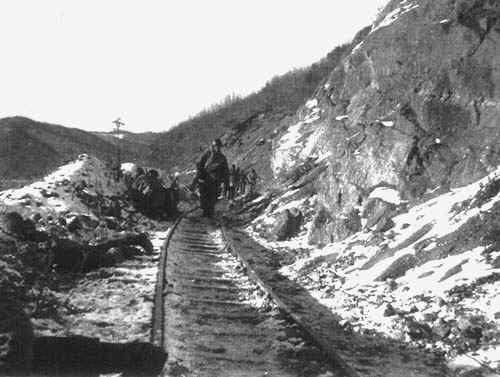
"On the way out on 1 December. The
soldiers are from M3/31, part of the rear guard. The two men lying in the foreground
are dead. The road is just over the bank (below) to the left. The trucks at this
time are about 100 yards behind me. A Chinese foot column is less than 100 yards to
the rear of the men pulling out. Heavy fire is coming from the hill in the
background. Time was about 1530 hours." ‐ MSG Wm. Donovan
SOME WOUNDED
GOT HIT AGAIN
To our left I could see ragged lines of Chinese troops
forming in the valley below, even though our covering aircraft dived on them time
and again. The Chinese were too far away for any effective rifle fire, but seeing
them reforming for new attacks was no comfort. On our right the enemy were in the
commanding spots on the ridges and were having a field day firing into our truck
column and its escorting guard. Wounded men in the trucks were getting additional
wounds and set up a mournful racket for someone to help them. Nothing could be done
for them. Officers began forming groups to flank the roadblock ahead and also to
clear the Chinese‐held hillside overlooking our column. The men were
reluctant to get going when they saw men on all sides of them being shot down by
Chinese fire. At first a few began to inch their way up the steep hill that began
abruptly at the roadside, then others joined. This action had a snowballing effect
and a platoon soon took the top of the ridge and then went over the other side. This
at least cleared part of the ridge, but fire was still coming from the roadblock and
the ridges to
the right front.
Dozens of soldiers
huddled and crouched around the trucks seeking protection and not heeding the call
of their officers to charge over the hill to support the initial group of GIs. The
dull boom of enemy mortars began a new tale. Out to our left the bursts began
creeping closer to our column. Included in this fire were deadly and much‐
feared white phosphorous shells which can burn the flesh right off one's bones
in seconds. About this time a wild‐eyed ROK soldier jumped into the truck and
flung himself on top of the wounded causing them to yell with new pain. He
wasn't wounded, just out of his head, I guess. But he wasn't so far out of
his head that he failed to recognize what I wanted of him when I picked up my
carbine and shoved the barrel in his face, yelling at him to get the hell out of the
truck. I was so mad at the s.o.b. for jumping in like that I would have gladly blown
his head off. He got out pronto and lost himself in the crowd of others milling in
the area.
As mortar fire continued to come closer I made up my
mind, despite my aching leg, to get out somehow. We had been stalled too long and it
was growing darker by the minute. No progress had been made in reducing the
roadblock and the Chinese were still pouring deadly fire from positions forward and
above us. I pulled myself out between the other wounded and dropped to the ground
behind the truck. I had the carbine with a full clip of ammunition ready to shoot.
Lt. [Charles] Curtis [I3/31]
hailed me and came up to join me in the ditch for a quick conference. We decided there was
only one thing to do – go over the hill as had the others, even though it meant taking
a chance of getting hit. To stay would lead to capture or eventually getting shot in the
truck. A decision was quickly reached to get going over the hill. Rallying about 20 other
men to go with us, we jumped up and scrambled up the hill firing as we went. We
couldn't see the Chinese but we knew where they were and could feel their fire coming
in and around us. My carbine fired two times, then failed to function. I threw it down,
picked up another from a dead GI, and kept going until we reached the top and safety on the
other side. We headed back toward the road on the far side [beyond] the enemy held
roadblock.
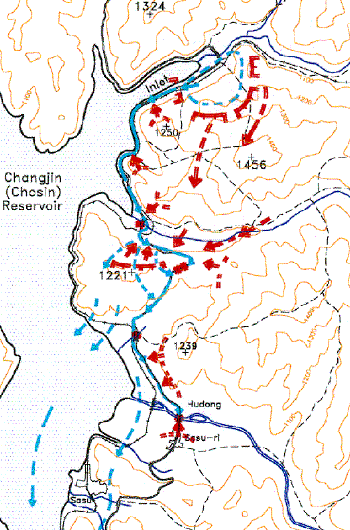
Map 8‐8a the Chosin Chronology
Click on the map for a full‐screen image; use your Back
button to return to this text.
Breakout east of Chosin.
The final killing ground was between Hill 1329 (just north of Hudong‐ni) and the
road, the hill having been occupied since the night of 27 November. The Chinese never did
launch a major attack against the Hudong‐ni perimeter, probably because of the
presence of the 31st Tank Company. After the Tank Company and others were withdrawn to
Hagaru‐ri on 30 November, the Chinese obviously adjusted their strength against the
units attempting the breakout from the north.
REMAINS OF A RELIEF
FORCE
As we arrived at the road it had grown dark. We could see the
burned‐out hulks of American tanks. This had been the limit of advance of the task
force [31st Tank Company] that tried in vain to relieve our surrounded force the day before
[two days before, 29 November]. We came upon Capt. [Earl H.] Jordan, M Company [3/31]
commander, who was organizing a group to knock out the roadblock from the rear. Once getting
his band together, he set off and was soon banging away in a firefight. It was quite dark by
then but we could see the flashes of gunfire. The group of 20 swelled to about 50 on the
road and they sat around or milled about trying to decide the next move. There was no
organization left. Men of all units were mixed up at this stage. Again Lt. Curtis and I came
to our decision as to what to do. We were going on to Hagaru‐ri where the marines
were holding, or where we thought they were holding. What lay between, we could only guess.
Maj. [Robert E.] Jones of the 32d Infantry [1/32] and Capt. [Ted] Goss from the 57th FA
Battalion [B/57FA] came up about this time and joined us with a few men they had led out. We
formed two long lines of soldiers on each side of the road and moved out quietly to the
south. As we moved along the group swelled in size until there must have been a hundred or
more.
Crossing another bridge that had been severely damaged, we ran into
an enemy outpost which immediately opened fire. Our troops dove off the road but kept going
forward. I was near the tail of the column, having dropped back as my leg began to stiffen
and slow me down. I had become separated from Lt. Curtis by that time, but Capt. Goss stayed
with me, which I appreciated. Being left behind was no rosy prospect. When the group hit the
sides of the road after being fired on they broke into two units, one going down a
narrow‐gauge railroad paralleling the dirt road, the other cutting sharply to the
right and hugging the frozen lakeshore [reservoir] path. I was with the latter group. We
were about 30 in number and actually had a better chance to move undetected through the
Chinese positions. We passed through a small logging village [Sasu‐ri] expecting any
minute to be ambushed, but got to the other side without incident. Another few miles and we
began to feel safer. This was short‐lived for we got another sharp challenge in
Chinese as we approached a bend in the path. We silently ducked to the right once more and
kept going. A few yards further we arrived at the ice of the reservoir and moved across an
inlet. After we moved about 800 yards a string of .50 caliber tracers licked out after us.
The Chinese were poor shots in the darkness and no one was hit, though a few rounds came
uncomfortably close.
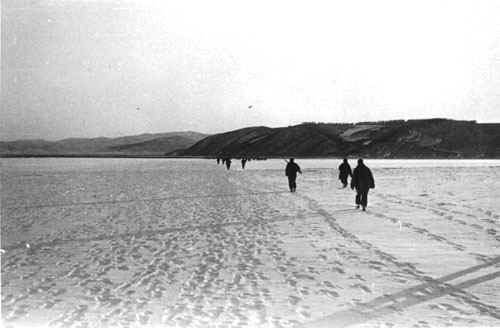
Walk of the Long shadows. Men crossing the ice
of the reservoir, many footprints, a low sun causing long shadows, sun about to set.
This same photo appears on the dust cover of Roy Appleman's book EAST OF CHOSIN.
‐ Photo by MSG Ivan Long (the late LTC Ivan Long, USAR).
About 2230 hours
we could see flashes of machine gun and artillery fire in the distance. This was, in our
estimation, the site of the marines at Hagaru. Our big concern was that the Chinese
would have the town cut off from the north, the direction from which we were
approaching. We had no information on the marines' situation prior to our breakout
and it was anybody's guess as to the real picture up ahead.
HALT’ AND SAFE AT LAST
We held a council of war and decided that we would
risk it and move forward and take our chances. Staying overnight in the hills would
invite freezing and perhaps capture, so moving ahead seemed the best bet. With caution
and with greater intervals between men, we approached the flashes of fire, noise we
could hear loud and clear. About a hundred yards along the route we were startled by a
loud but unmistakable American "Halt!" Boy, that was the best word I had ever
heard in my life. The marines challenged us, then led us into their lines. We were safe
at last and could let down a little. They had been prepared for us as the aircraft
overhead had alerted them we would be coming out during the night. Hot food and medical
attention followed, then a place to sleep for the rest of the night. As I drifted off to
sleep that night I could say my prayers with full assurance that I had a lot of
assistance from the good Lord that day.
END NOTES
Although
Hugh Robbins has been cited as a source by historians Roy Appleman and others, we
believe it important that readers interested in Chosin see his complete manuscript. It
reflects the mind's eye of one person who experienced Chosin and survived to tell
his story, similar to those of Herb Bryant (CJ10.30.00) and Ted Magill (CJ12.15.02).
It's also important to understand the relationship between Robbins' experience
and previous journals (CJ11.27.03 on Mao's Generals) which provided limited insight
into the Chinese side. RCT 31 units confronted a large Chinese force that had launched
its main effort down the east side of the reservoir. Not only was the enemy delayed in
the mission of taking Hagaru‐ri, the tenacity of the Army units’
do‐or‐die defensive action for five nights and four days debilitated more
than two CCF divisions to the point where they were lost from further participation in
the Chosin campaign. In the west, the Chinese were no longer capable of cutting off
Marine regiments that launched their own breakout from Yudam‐ni at the same time
RCT 31 units were being destroyed at the east‐side anvil ‐ Hill 1221. From
then on it was downhill for the Chinese as their logistics system became a dribble while
most of their soldiers were "captured" by Father Winter.
END CJ 02.28.04
|


